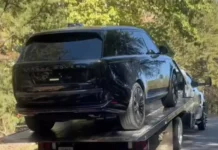Simson Source
Established in the city of Suhl by Lob and Moses, Simson initially started as a weapons manufacturing plant. Simson began producing motorcycles in 1934 under the BSW brand (short for Berlin-Suhler Weapons, meaning Berlin-Suhler weapons factory). One of the models produced by the company was the BSW 100 vintage motorcycle.
.jpg) BSW 100
BSW 100
During the Nazi era, the Simson family, who were Jewish, faced persecution and were forced to leave the country. Meanwhile, the factory was transformed into a center for weapons production by Hitler. After the fall of the Nazi regime, Simson was one of the first factories in Germany to be taken over by the Soviet Union. As a result, many cars and motorcycles in East Germany had their origins in pre-war models produced by East German brands like Trabant, Wartburg, MZ, and Simson.
The Simson Motorcycle Generations
Simson 425 – 1951
The first version of Simson was the AWO-Simson 425 – a single-cylinder BMW vintage motorcycle with a 4-stroke 250cc engine (placed longitudinally) and a 4-speed gearbox.
.jpg) Simson 425
Simson 425
Next was the Sport version, which featured an improved suspension system (rear swingarm) and a completely new appearance, with 15 horsepower and a top speed of 110 km/h. The 425 model is still popular in the former East Germany. Sometimes, this version is also used as a base for creating unique custom motorcycles.
Later on, many racing bikes were inspired by the AWO-Simson 425 model. Examples include the 1951 and 1954 models with 26-28 horsepower, while the 1955 model, with a similar construction to its “predecessors”, except for the dual overhead camshafts, produced 30 horsepower at a maximum engine speed of 9200 rpm.
Simson RS 250 – 1952
From 1952 to 1953, Simson introduced a brand new 4-stroke racing motorcycle called the RS 250, equipped with a single-cylinder engine and a 6-speed gearbox. This engine was named “The Seven” because of the design of the camshaft drive, which had the ability to produce 33 horsepower. The bike featured an Earles fork and a dual shock absorber system.
.jpg) Simson RS 250
Simson RS 250
In 1956, another visually appealing racing model was introduced. This model had a 2-cylinder engine with a 250cc displacement, producing 35 horsepower at an engine speed of 10,200 rpm, a DOHC valve drive, and a frame similar to that of the RS 250. However, under the orders of the Soviet Union government, the production of racing motorcycles had to be stopped. Nevertheless, these racing motorcycles proved that Simson was not limited to producing only 2-stroke models.
Simson GS 350 – 1956
In 1956, Simson made significant efforts to compete in the Enduro market. A notable example of this competition was the GS 350, which was derived from the 425 model, equipped with a 350cc engine and with 20 horsepower.
.jpg) GS 350
GS 350
The last improved version of the 4-stroke Simson model was the E-350, created in 1960 but never mass-produced. This was a highly regrettable decision, as the E-350 had a very sleek and modern appearance. Furthermore, the E-350 was the first motorcycle to be equipped with turn signals.
After this period, Simson shifted its focus to producing smaller and more affordable models, such as the Schwalbe with a 2.1 horsepower engine and a top speed of 50 km/h, the SR-2E mopeds with a 1.5 horsepower engine, and the S3-Star scooters. All these models were produced between the late 1950s and 1960s. Among them, the Schwalbe had a production run of over 1 million units.
S-51: After the 70s
In the 1970s, the notable S-51 model was the only remaining popular Simson motorbike in East Germany until the fall of communism. This bike also used a fixed-mounted 70cc engine with either a 3-speed or 4-speed gearbox and a steel tube frame. The enduro version of the S-51 (with a 70cc or 80cc engine) was more prominent, featuring an additional load-bearing tube, a 5-speed gearbox, and 7.5 horsepower.
.jpg) Simson S-51
Simson S-51
During this period, Simson produced many special racing models, such as the 1975 model with a 50cc engine derived from the Schwalbe moped, a 6-speed gearbox, a liquid cooling system, reed valve intake, and a maximum output of 16.5 horsepower. Additionally, there were also custom models based on the S-51 with an 80cc engine, an aluminum frame, disc brakes, and a monoshock suspension.
These Simson models were relatively affordable and had simple construction. The SR-1, for example, resembled the early Italian scooters, had a 2-stroke engine from Simson mopeds, manual transmission, and a steel tube frame. By the early 1990s, Simson’s glorious victories began to fade due to the post-communist crisis.
GS 80 – The 80s
From the 1980s, Simson completely redesigned its Enduro bikes. For instance, the GS 80, introduced in 1981, featured a modern air-cooled engine, a 6-speed gearbox, and 23 horsepower. Apart from the GS 80, there was the GS 80 WKH in 1987, which had a 7-speed gearbox, and the 1990 version – the winner of the World Championship and victorious against TM Italy enduro motorcycles.
.jpg) GS 80
GS 80
During this time, Simson produced several outstanding racing motorcycles, such as the 1990 S-53 model, which had a 50cc engine, a 5-speed gearbox, a monoshock suspension, and a disc brake system.
Currently, Simson is only a part of the history of East Germany. Despite making great efforts to modernize, the Simson factory had to close its doors in 2002, and the engine production line was transferred to Russia. One remarkable thing is that Simson products, although cheap and lacking distinctive features, were highly useful for the people of East Germany.
Thao Anh compiled (TTTD)









































